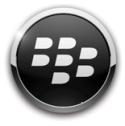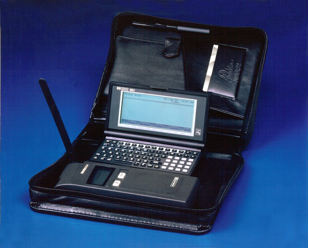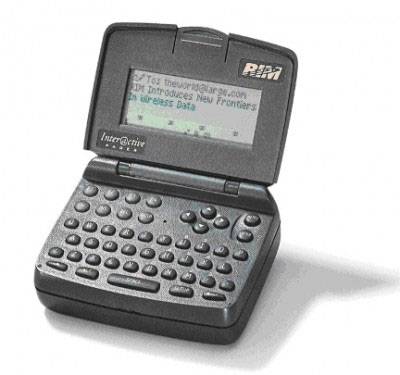Back in the early 1990s, we didn’t have BlackBerries or any kind of wireless data devices. Phones weren’t very “smart,” and dial up still ruled the land. Then a trio of companies came together to invent the Viking Express which was a combination of an Ericsson Mobidem wireless data modem that was the size of a small brick, an HP 100 pocket-sized computer that looked more like a big calculator, and software from a company called Radiomail that ran on the DOS operating system of the HP. The world of wireless hasn’t been the same since.

I remember sending an email from my car on the New Jersey Turnpike, pulling over after I passed through one of the toll barriers. A cop came along and wanted to know what I was doing. It was probably the first time he had seen such an assemblage of devices.
The evolution of the BlackBerry came from three key elements: a network, a device, and special secret software sauce that connected the two. Let’s talk about each of these and see how they contributed to the little smartphone that we all now love.

The Network: Mobitex
The Mobidem was so called because it ran on a specialized data-only wireless network called Mobitex that stared in Sweden and spread to North America. At the time, the cellular networks didn’t do data: saying that now is somewhat odd since data plans are so ingrained into our consciousness (or at least our monthly bills). But back in the 1990s there were competing data-only networks that were vying for contention. Mobitex was run in the US by BellSouth, which eventually became part of the present AT&T Wireless network. Motorola backed another network for its data paging service called ARDIS, and there was a third network that AT&T was betting on called Cellular Digital Packet Data or CDPD.
Back in the mid-1990s, if you had a wireless device it had to run one of these three networks. The competition was fierce among the trio, and unlike today where you have multiple-band radios in most phones, no one was going to make devices for more than one network, just because the radios were huge and power-hungry.
The beginning of the end of the separate data-only networks were when United Parcel Service introduced its own wireless signature pad tracking devices. They needed a device that could connect anywhere, and while the data-only networks had decent coverage, the cellular voice networks had better coverage. That was one of the first big sales of wireless data. The other spike that killed off data-only networks was the cellular voice networks getting lots of capital improvements and getting faster throughputs to handle data conversations.
But It’s the Software
The parade of various hardware devices is nice, but really what lies at the heart and soul of RIM is its software. This software has two important pieces: what runs on the device and what runs across the network. Both were innovations that drew on many different contributions.
Radiomail was one of the first to understand how to push emails to wireless devices. But its innovations were never patented due to the philosophy of its founder, Geoff Goodfellow. Ironically, RIM went on to become one of the more litigious computer vendors, and they had to pay $615 million to obtain the rights for patents for the process in the end.
The other piece was actually quite clever for its time, in the late 1990s: the BlackBerry Enterprise Server. The idea was to have this run on a Windows PC that would be located in your data center, next to a Microsoft Exchange server. Emails would be sent out over the network and pushed to the individual Blackberry devices registered to a user’s email account. Before this invention, you didn’t have any simple way of synchronizing your emails between device and desktop.
RIM also used end-to-end encryption for its mail stream, which was possible because it owned all the pieces of the network, software and device. This would prove to be both a blessing and a curse, as recently several countries have temporarily blocked BlackBerry usage because the emails couldn’t be decrypted.
The Hardware
Once the network and software were in place, RIM proceeded to produce a series of devices that could be carried around. The precursors to the BlackBerries were actually called something else entirely, and were a big bigger than the average alphanumeric pagers, which they were based on. RIM’s first devices in 1994 were called the Inter@ctive Pager 850 and 900. Each had a four line character-only screen and a keyboard with tiny keys, that latter still something the current BlackBerries have in common. At the time, these sold for $400 plus $40 a month for unlimited data usage (some things don’t change, although the definition of “unlimited usage” sure has). They had a single AA battery that would last up to three days. Remember, these didn’t have any voice capabilities, and were just used for email purposes.

Then in 1999, RIM launched a revolution. The first actual BlackBerry models were smaller than the clamshell design of the 850/900 but still used the same character-mode text displays.
From that point on, we started to see BlackBerries everywhere: first came phone features, then the ability to surf the Web, then full color graphical UIs that we have today. Here is a review of some of the older models.
RIM has certainly come a long way since the early days. But this is the first time in its history that both co-CEOs aren’t running the company, as we mention in our article earlier today. Perhaps this is a good thing, but as Rowinski says in his post, it will be a tough road ahead.










